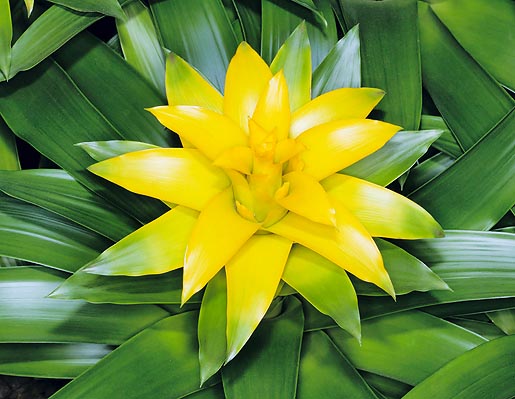Family : Bromeliaceae

Text © Pietro Puccio

English translation by Mario Beltramini

The hybrid ‘Hilda’, maybe born from Guzmania lingulata, is most common © G. Mazza
The Guzmania Ruiz & Pav. (1802) is native to the pluvial forests of subtropical and tropical America (Belize, Bolivia, Brazil, Colombia, Costa Rica, Cuba, Dominican Republic, Ecuador, French Guyana, Guatemala, Guyana, Haiti, Jamaica, Leeward Islands, Nicaragua, Panama, Peru, Puerto Rico, Trinidad and Tobago and Venezuela).
The genus is honoured to the Spanish naturalist Anastasio Guzman (†1807).
The genus contains about 200 herbaceous plants, evergreen, monocarpic (bearing fruit only one time during its existence), mostly epiphytic. They are characterized as having unarmed and rather flexible leaves, of a usually green colour, placed in way to form a rosette with the central cavity normally full of water, and long lasting inflorescences with showy bracts of several colours, as well as the flowers, whose petals are blended to form a tube.
The plants being cultivated are not many, whilst countless are the hybrids and the varieties produced in great quantity as indoor plants.
Guzmania ‘Hilda’
Hybrid of unknown origin, possibly from Guzmania lingulata, one of the most popular and appreciated for its leaves long about 45 cm of a glossy intense green colour, thin and flexible, and the lemon-yellow bracts of the inflorescence, tall up to about 40 cm, which develops at the centre of the rosette. The flowers are white and short lasting, but the bracts, which are the main attraction, keep their colour even for 2-3 months.
It requires light substrata, draining, sandy, acidic or neutral, kept humid, temperatures which are not to be below 16°C and a high ambient humidity or, as last resource, in presence of dry air and high temperatures, very light, short lasting nebulisations, utilizing water at room temperature and not calcareous, in order not to cause un-aesthetic dots on the leaves. It adapts to poorly luminous positions, therefore to places where other plants would survive with difficulty. In the tropical and subtropical climates, it is often cultivated for covering the soil at the shade of big trees.
It reproduces by vegetative way through the new plants which come out between the leaves from axillary gemmae, which can be detached when they have reached the size of at least one third of the mother plant; the reproduction on a large scale for commercial purposes is done by micro-propagation.
→ For general notions about BROMELIACEAE please click here.
